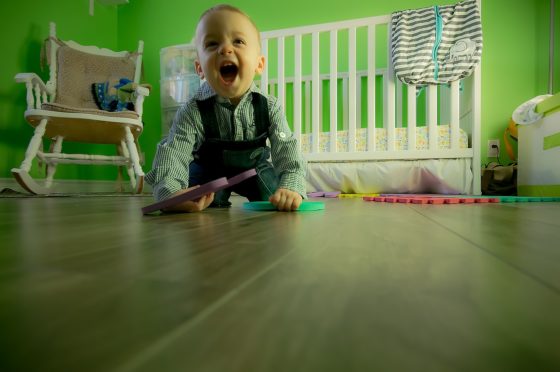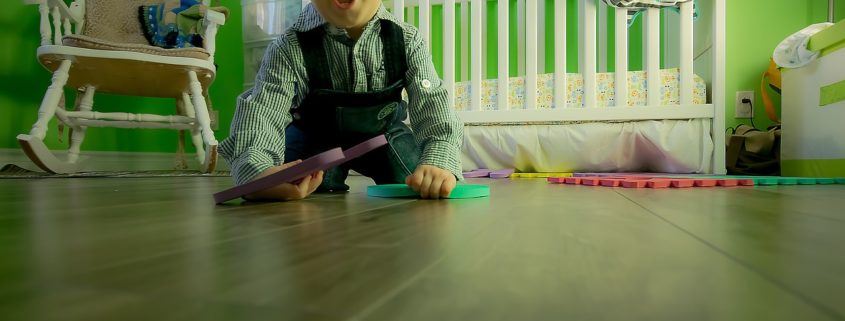Baby Language: Communication Milestones for Ages 0-3

Contents
What is communication?
First, we should start by defining communication. Communication describes any process by which two or more people share information. In the field of child development, the terms communication and language are often used synonymously, although language specifically describes a system of communication involving words (spoken, written, or signed).
There are two parts to communication: Receptive communication and expressive communication. Receptive is the input side of communication: “the ability to understand information. It involves understanding the words, sentences, and meaning of what others say or what is read.” Expressive is the output side of communication: the ability to “put thoughts into words and sentences, in a way that makes sense and is grammatically accurate,” including gestures, writing, and typing.
See also: Is Baby Talk Good for Your Baby?
Baby Language: Communication Milestones
All children develop at different rates, but here are some basic communication milestones that a child should reach around each age. It’s important to note that these vary, however —
A full-term newborn baby will:
- Have primitive reflexes of rooting and sucking, which are essential for feeding;
- Alert or startle at noises; and
- Cry varying in tone and pitch.
Around the age of 2 months will:
- Smile in response to interaction;
- Turn when she hears your voice;
- Become still when she hears a sound; and
- Coo and gurgle.
A 4-month-old will:
- Laugh;
- Squeal; and
- Vary her cries depending on need.
A 6-month-old will:
- Begin to babble (meaningless), with mainly vowel sounds;
- Copy sounds, like blowing a raspberry, and blows bubbles for fun; and
- Respond to sound by making a sound.
A 9-month-old will:
- Begin to use specific two-syllable babble such as “mama,” and “dada;”
- Begin to point with her finger;
- Begin to use gestures such as “bye” and “up;” and
- Enjoy gesture games such as patty-cake and peekaboo.
A 12-month-old will:
- Use one word with meaning;
- Respond to the word “NO” and shake her head;
- Respond to her own name;
- Follow a one-step command with a gesture;
- Repeat sounds to get attention; and
- Imitate adult sounds: babble mimics flow of speech.
A 15-month-old will:
- Point to one body part;
- Follow a one-step command with no gesture;
- Use around five words correctly;
- Begin to use jargon;
- Indicate desires with gestures or grunts; and
- Bring objects to you, like a toy or book.
An 18-month-old will:
- Point to a common object and around three body parts;
- Use 10-25 words;
- Use jargon embedded in real words; and
- Label familiar objects.
A 2-year-old will:
- Follow a two-step instruction;
- Use 50+ words, but half will be unintelligible;
- Join two words or more into phrases;
- Use personal pronouns (I, me, you) and simple plurals; and
- Knows the names of familiar people.
A 3-year-old will:
- Follow a two- to three-step instruction;
- Have a vocabulary of around 200 words, most of which a stranger can understand;
- Talk in 3-4 word sentences;
- Ask questions (why, what, who, where, when);
- Say own name, age, and gender;
- Understand words like “in,” “on” and “under;”
- Name a friend; and
- Engage in a simple two-way conversation.
A Note on Premature Babies
Premature babies will reach their early milestones based on their due date, not their birth date. All children are different, and there is a wide range of ages at which milestones are achieved. For additional information on communication development all the way through age 5, visit the Centers for Disease Control and Prevention website.
See also: Premature Birth: What Does it Mean for Your Baby?
Communication Problems
Before we get into any communication red flags, it’s important to know some of the disorders that can be diagnosed based on communication milestones. They include the following.
Autism or Autistic Spectrum Disorder (ASD)
ASD is a neuro-developmental disorder affecting 1 in 68 children in the U.S. Early communication signs of ASD include delay in making eye contact and social smiling, delayed or unusual language development, odd voice (flat or sing-songy), limited facial expressions or use of gestures, and failing to communicate needs.
Cerebral Palsy (CP)
CP affects 1 in 323 children in the U.S. and speech delay or abnormalities are common, usually affecting expressive language. It is most commonly seen in athetoid CP. A child’s speech may be “hard to understand if they experience difficulties with the production of sounds, due to poor control of breathing, tongue, and vocal cords. They may also have difficulty understanding the spoken word.”
See also: The Best Speech Therapy for Cerebral Palsy
Hearing Loss
About 1 in 500 infants is born with or develops hearing loss during early childhood. Hearing loss in the early months can lead to severe speech delay. Parents may notice that their infant does not startle, quiet, or turn toward sound. In later months, a child with hearing loss may develop speech that is slurred or difficult to understand.
When to Call Your Doctor: Red Flags
According to the American Academy of Pediatrics, developmental assessments should be performed at 9 months, 18 months, and 24/30 months. Babies who were premature, low birth or had problems (like infection or trauma) in the womb, during birth, or in the early months may need to be screened more frequently.
Remember, every child is different and attains milestones at their own pace. Talk to your doctor if you notice:
- Feeding or swallowing problems
- Poor response to sound
- Delayed milestones
- Recurrent or persistent infections of ears, throat, or chest
- Your 2-year-old is hard to understand
- Lack of gestures or range of facial expressions
- Any regression of skills (loss of skills previously gained)
If your doctor is concerned, he or she may refer your child for assessment in audiology, speech pathology, neurology, or developmental pediatrics.
Keeping a record of your child’s development is not only interesting, but it can be invaluable if your child is having problems. It may reassure you that everything is actually progressing normally or give useful information to your health care professionals to aid diagnosis.








Leave a Reply
Want to join the discussion?Feel free to contribute!